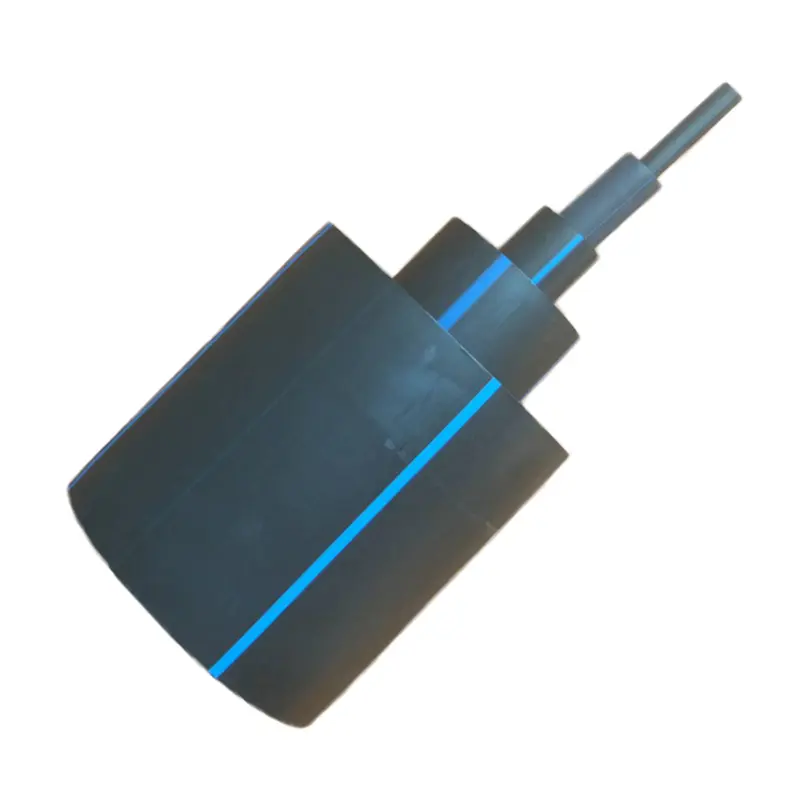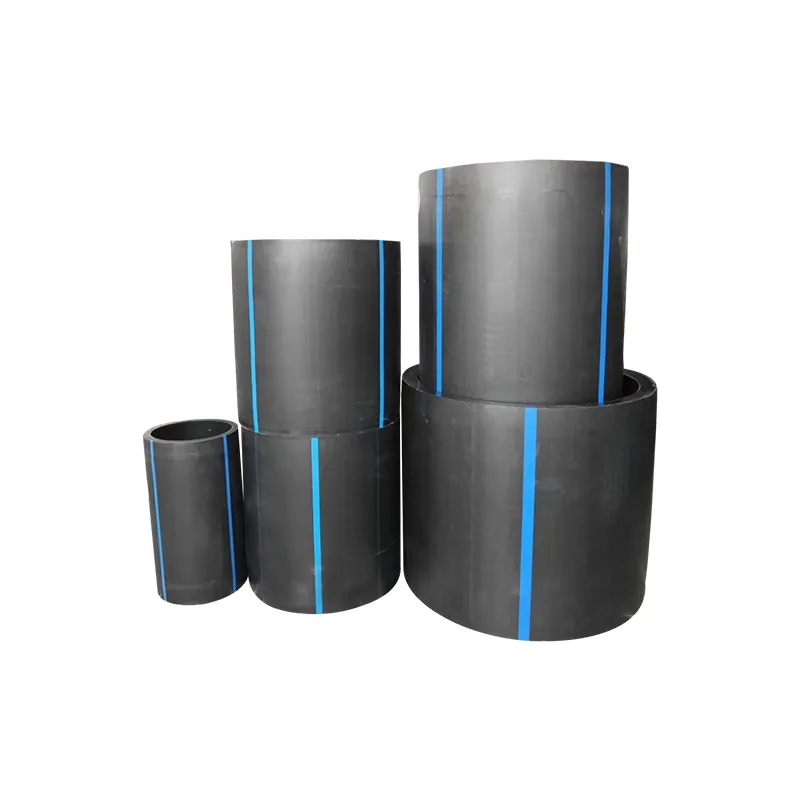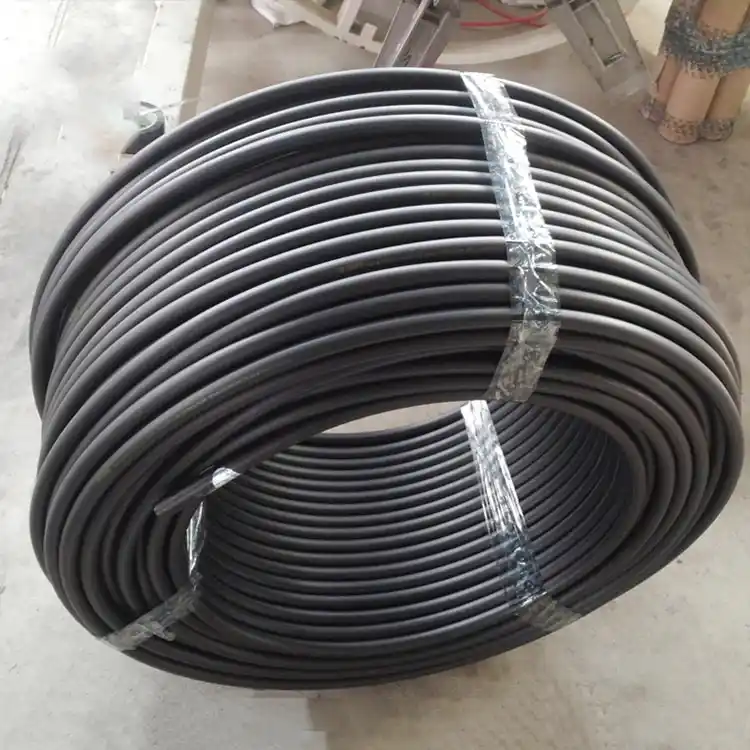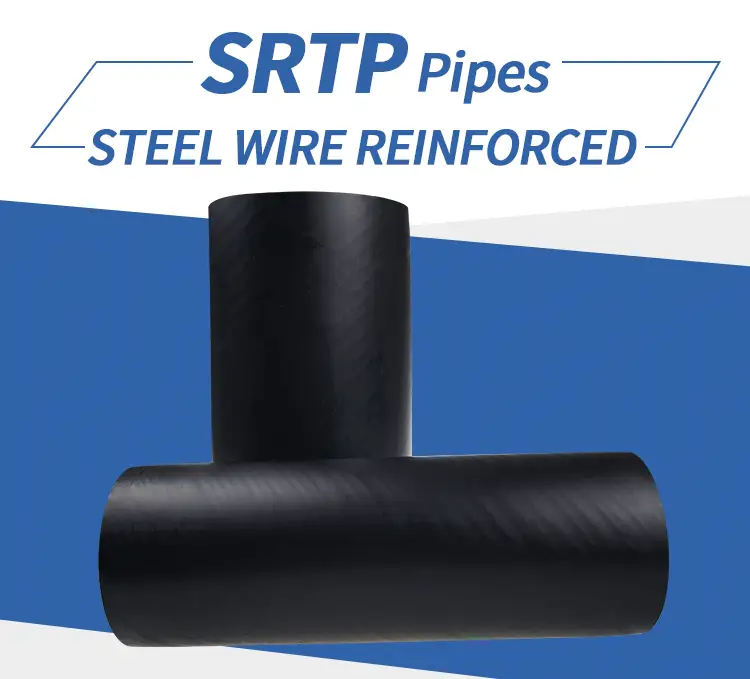Poly Pipe in Black/Blue Color for Water Supply
Buy the best quality HDPE Pipe (Poly Pipe) In Black/Blue Color For Water Supply from Sunplast now. Top quality, great selection and expert a...
HDPE SDR 11 2 inch Poly Pipe
HDPE SDR 11 2-inch poly pipe is a type of high-density polyethylene (HDPE) pipe commonly used in various applications such as water supply, ...
200mm hdpe pipe for renewable energy systems
Renewable energy sources such as solar, wind, hydro, and geothermal power have gained significant traction in recent years as we strive to r...
HDPE Water Pipe 16-1600mm
Upgrade your plumbing infrastructure with our high-quality HDPE water pipes. Engineered for unmatched performance and durability, our pipes ...
HDPE Irrigation Pipe
HDPE irrigation pipes are highly durable, flexible, and resistant to chemicals and UV radiation, making them an excellent choice for transpo...
PE Black Water Pipes
PE black water pipes are used for a variety of purposes. Some of the uses of black water pipes include irrigation, drainage, and sewage.
2 inch Poly Pipe 1000 ft
Looking for a reliable and durable 2 inch poly pipe 1000 ft? Look no further! Our selection of HDPE and LDPE poly pipes are suitable for wat...
HDPE Pipe for Water PE100
HDPE water pipes are a durable and flexible solution for water distribution systems. These pipes offer excellent chemical resistance, making...
2 HDPE Water Pipe Roll 1000' Specification
2 hdpe water pipe roll 1000' has a variety of construction technologies. In addition to traditional excavation methods, they can also use a ...
Steel wire reinforced thermoplastic (PE) pipe SRTP pipe
Steel wire reinforced thermoplastic (PE) pipe has the common characteristics of anti-corrosion, non-scaling, smooth and low-resistance, non-...
Steel wire mesh reinforced PE pipe (SRTP pipe)
Steel wire mesh reinforced PE pipe is used for conveying drinking water and there is no doubt of secondary pollution. It is hygienic, non-to...
2 in. x 500 ft x1000 ft HDPE water pipe roll wholesale
2 in. x 500 ft and 2 in. x 1000 ft HDPE water pipes are the two most commonly used shipping storage sizes. Good hdpe water pipe, good price,...
Black SRTP pipes (steel wire reinforced)
SRTP pipe overcomes the respective disadvantages of the steel pipe and the plastic pipe, while maintaining the respective advantages of the ...
Polyethylene (PE) pipes for water supply
We are a manufacturer and supplier of polyethylene (PE) pipes for water from China. We provide various specifications of high-quality polyet...
☛HDPE Water Pipe Guide
Table of Contents
Chapter 1: About HDPE water pipe
1.2 How many kinds of hdpe water pipes?
1.3 HDPE water pipe applications
1.4 Do HDPE water pipes come with a warranty, and what is covered under the warranty?
1.5 Can HDPE water pipes be used for both aboveground and underground applications?
1.9 Can HDPE water pipes be recycled, and if so, how do I go about recycling them?
Chapter 2: HDPE water pipe packing and shipping
Chapter 1: About HDPE water pipe
Outdoor HDPE Water pipe is applicable to Municipal water supply, Farmland irrigation, Fire pipeline, Reclaimed water reuse, Road works, clearing the river channel, Sports stadium, Factory fluid transmission, and other fields. All the Outdoor Water Pipe products are made of brand-new materials and meet the sanitary standards for potable water. The size and pressure rating of the Outdoor HDPE Water Pipes can meet various water supply design schemes. We can provide you with all kinds of pipe fittings and joint parts. Mainly for dealers and customer groups in East Asia, South Asia, South America, the Middle East, and Africa.
We are an Outdoor HDPE Water Pipe manufacturer and supplier from China. If you plan to purchase a large number of outdoor water pipes. You can contact our factory. We provide a complete water pipe procurement scheme.
High-density polyethylene (HDPE) water pipes are a type of plastic pipe commonly used for water supply systems. HDPE water pipes offer several benefits over traditional pipe materials such as metal or concrete, including:
1. Durability: HDPE water pipes are highly resistant to chemical and environmental damage, meaning they can withstand the elements and last for many years.
2. Corrosion resistance: HDPE water pipes are highly resistant to corrosion and rust, meaning they will not corrode over time as metal pipes will.
3. Flexibility: HDPE water pipes are flexible and easily bendable, meaning they can be used in tight spaces or curved layouts without the need for joints and fittings.
4. Lightweight: HDPE water pipes are lightweight, making them easy to transport, handle, and install.
5. Cost-effective: HDPE water pipes are relatively inexpensive compared to other piping materials.
HDPE water pipes come in a range of sizes, depending on the application and required flow rate. They are commonly used for water supply systems in residential, commercial, and industrial settings, as well as for irrigation systems and firefighting systems. The choice of pipe size will depend on the required flow rate, pressure, and other factors critical to meeting the system requirements. When it comes to installation of HDPE water pipes, it is critical to follow the manufacturer's instructions and best practices in order to ensure a reliable and durable installation. This includes proper handling, storage, and transportation of the pipes, as well as proper connections, fittings, and jointing. A professional installation crew should be used for projects where the pipes are used for utility piping or supplying drinking water.
1.2 How many kinds of hdpe water pipes?
High-density polyethylene (HDPE) water pipes are available in different sizes and types to suit different applications. The main types of HDPE water pipes include the following:
1. PE-80: This is a medium-density grade HDPE water pipe, typically used for water supply systems, gas distribution systems, and other similar applications. It has good resistance to chemicals and is particularly suitable for outdoor use.
2. PE-100: This is the highest density grade of HDPE water pipe and is suitable for high-pressure applications such as large-scale water supply systems, sewage systems, and industrial applications. PE-100 pipes are resistant to chemicals and abrasion and have a long lifespan.
3. HDPE Pipes for Irrigation: HDPE water pipes are ideal for irrigation systems because of their flexibility, durability, and resistance to weathering. These pipes come in different pressure ratings and diameters to suit different irrigation applications.
4. Large-Diameter HDPE Pipes: Large-diameter HDPE water pipes are used for large-scale water supply systems, water mains, and other similar applications. These pipes are typically used for outdoor installations and can come in diameters exceeding 2000mm.
Overall, HDPE water pipes can be classified into different grades based on their density and pressure ratings. The specific type of HDPE water pipe used will depend on the application and the required pressure and flow rate. It is crucial to select the right type of HDPE pipe for a project to ensure a reliable and durable installation.
1.3 HDPE Water Pipe Applications
HDPE (High-Density Polyethylene) water pipes are commonly used in municipal water distribution systems, industrial and mining water supply, irrigation systems, and rural water supply systems. HDPE water pipes are popular for their durability, flexibility, and chemical resistance, making them a reliable and cost-effective option for many different applications. Some of the key HDPE water pipe applications include: Municipal water distribution systems: HDPE water pipes are commonly used for water distribution in cities and towns, replacing traditional pipes made of iron, concrete, or PVC.
1. Potable water distribution: HDPE pipes are often used for the distribution of drinking water. They are commonly used to replace aging pipelines made of materials like iron, steel or cement due to their corrosion resistance, leak-free joints, and ease of installation.
2. Wastewater and sewage systems: HDPE pipe is also used in sewage and wastewater systems. This is because HDPE is resistant to various chemicals and compounds commonly found in wastewater, and can withstand harsh environmental conditions.
3. Irrigation systems: HDPE is often used for the distribution of irrigation water. This is because HDPE pipes feature a smooth inner surface that minimizes water pressure losses and allows for an efficient flow of water. 4. Stormwater management: HDPE pipes are used in stormwater management and drainage systems. This is because HDPE pipes are lightweight, durable, and can handle high-volume flows of water.
5. Industrial applications: HDPE pipes are used in industrial applications where pipes are exposed to high temperatures, chemicals, and other harsh conditions. They are used for transporting chemicals, acids, and other hazardous materials.
6. Rural water supply systems: HDPE water pipes are also commonly used in rural areas, where water supply systems are less developed or where the terrain is challenging. HDPE pipes can be used for both above-ground and buried installations in rural areas.
7. Oil and gas applications: HDPE water pipes are also used in the oil and gas industry for the transportation of fluids, including brine water, crude oil, and natural gas. HDPE pipes are preferred for their lightweight, flexibility, and resistance to chemicals.
8. Municipalities use HDPE water pipes for their long life expectancy, leak-resistant fusion-welded joints, and ability to withstand extreme weather conditions.
Overall, HDPE pipes are a versatile and cost-effective solution for a wide range of water applications due to their durability, strength, and resistance to corrosion and leakage.
1.4 Do HDPE water pipes come with a warranty, and what is covered under the warranty?
The warranty for HDPE water pipes can vary depending on the manufacturer and the specific product. It is important to check with the manufacturer or supplier of the pipes to determine the specific terms of their warranty.
In general, HDPE water pipes may come with a warranty that covers defects in materials or workmanship. This means that if there is a problem with the pipes due to a manufacturing defect or a problem with the materials used, the manufacturer may provide a replacement or repair the pipes.
However, it is important to note that warranties typically do not cover damage caused by improper installation, misuse, or other external factors that are outside the control of the manufacturer. Therefore, it is important to follow the installation and maintenance instructions provided by the manufacturer to ensure that the warranty remains valid.
It is also important to keep in mind that warranties can vary in duration and coverage, so it is important to review the warranty information provided by the manufacturer to determine what is covered and for how long.
In addition to the points I mentioned earlier, it's worth noting that some manufacturers may offer a limited lifetime warranty on their HDPE water pipes. This means that the warranty will remain valid for the entire lifetime of the product, as long as it is used and maintained according to the manufacturer's instructions.
However, even with a limited lifetime warranty, there may be certain exclusions and limitations on the coverage. For example, the warranty may not cover damage caused by external factors such as natural disasters, accidents, or other events that are beyond the control of the manufacturer.
It's important to carefully review the warranty terms and conditions to fully understand what is covered and what is not. If you have any questions or concerns about the warranty, it's always a good idea to reach out to the manufacturer or supplier for clarification.
1.5 Can HDPE water pipes be used for both aboveground and underground applications?
HDPE water pipes can be used for both aboveground and underground applications. HDPE pipes are highly resistant to corrosion and chemical attacks, making them an ideal choice for water distribution and transmission systems. HDPE pipes are also flexible and can easily withstand ground movements, making them suitable for underground applications. Aboveground applications for HDPE pipes may include water distribution systems for buildings, irrigation systems, and even some industrial applications. However, it's important to note that the installation and design requirements for aboveground and underground applications may differ, and proper installation techniques must be followed to ensure the long-term performance of the HDPE water pipes.
1.6 How does the thermal expansion of HDPE water pipes affect their performance, and are there any precautions I should take?
Thermal expansion is a natural phenomenon that occurs in all materials when they are heated. HDPE water pipes are no exception, and they will expand when exposed to high temperatures. The degree of thermal expansion in HDPE pipes is relatively high compared to other materials, and it's important to take proper precautions to avoid damage to the pipes.
If HDPE water pipes are not installed correctly, they can buckle, deform or become damaged when subjected to thermal expansion. This can cause leaks, deformation or even failure of the pipe. Therefore, it's important to follow the manufacturer's installation instructions carefully and ensure that the pipes are properly supported to prevent sagging or buckling.
Additionally, it's important to consider the temperature of the water that will flow through the HDPE pipes. Higher temperatures will cause more expansion, and if the expansion is not accounted for, it can cause damage to the pipes. Therefore, it's important to factor in the expected operating temperature of the water when designing the system and selecting the appropriate HDPE pipe.
Precautions that can be taken to prevent damage due to thermal expansion include using expansion joints or loops, properly supporting the pipes, and allowing sufficient space for expansion. Expansion joints or loops provide flexibility to the system, allowing the pipe to expand and contract without damage. Proper support of the pipes will prevent sagging or buckling, which can damage the pipes. Providing sufficient space for expansion will also prevent the pipes from becoming compressed and damaged.
In summary, it's important to take proper precautions to account for thermal expansion when installing HDPE water pipes. Proper installation techniques, appropriate selection of HDPE pipes, and consideration of the expected operating temperature of the water can help prevent damage due to thermal expansion.
1.7 Can HDPE water pipes be used in areas with high seismic activity or where the ground is prone to movement?
HDPE water pipes can be used in areas with high seismic activity or where the ground is prone to movement. HDPE pipes have high flexibility and can easily withstand ground movements without cracking or breaking. In fact, HDPE pipes have been successfully used in earthquake-prone areas for many years.
One of the advantages of HDPE water pipes is that they have high resistance to cracking and stress caused by ground movements. This is due to the inherent flexibility of the material, which allows the pipes to bend and flex without breaking or cracking. Additionally, HDPE pipes are lightweight, making them easy to handle and install, which can be particularly advantageous in areas where heavy equipment may not be readily available or accessible.
However, it's important to note that proper installation techniques must be followed to ensure the long-term performance of HDPE water pipes in areas with high seismic activity or ground movement. For example, the pipes should be properly anchored and supported to prevent movement or buckling. Additionally, the design of the system should take into account the expected movement of the ground and factor this into the placement and installation of the pipes.
In summary, HDPE water pipes are a good choice for use in areas with high seismic activity or where the ground is prone to movement. The inherent flexibility and resistance to cracking make them a reliable choice, but proper installation techniques and design considerations must be followed to ensure the long-term performance of the system.
1.8 Are there any special considerations I should keep in mind when transporting or storing HDPE water pipes?
There are some special considerations to keep in mind when transporting or storing HDPE water pipes to ensure their performance and longevity:
Protection from direct sunlight: HDPE pipes are sensitive to UV radiation and can be damaged by prolonged exposure to sunlight. Therefore, they should be covered or stored in a shaded area to protect them from direct sunlight.
Temperature control: HDPE pipes should be stored in a location that is protected from extreme temperatures. High temperatures can cause the pipes to expand, while low temperatures can cause them to contract. This can lead to warping or deformation of the pipes, which can impact their performance.
Proper handling and transportation: HDPE pipes are lightweight and flexible, but they still require proper handling and transportation to prevent damage. The pipes should be lifted and moved using appropriate equipment, such as a forklift or crane, and should be stored on a flat surface to prevent deformation.
Protection from contaminants: HDPE pipes should be protected from contaminants such as dirt, rocks, and other debris during transportation and storage. This can help to prevent damage to the pipes and maintain their performance.
Proper stacking: HDPE pipes can be stacked for storage, but proper stacking techniques should be followed to prevent damage. The pipes should be stacked in a vertical position with the ends supported, and should not be stacked too high to prevent deformation.
By following these guidelines, you can ensure that your HDPE water pipes are stored and transported safely, protecting their performance and longevity.
1.9 Can HDPE water pipes be recycled, and if so, how do I go about recycling them?
HDPE water pipes are recyclable, and recycling them is a great way to reduce waste and conserve resources. Here are some steps you can take to recycle HDPE water pipes:
Contact a local recycling facility: Check with your local recycling center or waste management facility to see if they accept HDPE water pipes. They may have specific requirements for accepting the pipes, such as size or condition, so it's best to check first.
Prepare the pipes for recycling: Before recycling the pipes, make sure they are clean and free of any contaminants. Cut the pipes into manageable lengths if necessary and remove any fittings or other attachments.
Deliver the pipes to the recycling facility: Once the pipes are prepared for recycling, deliver them to the recycling facility. Some facilities may offer pick-up services, so it's worth asking if this is an option.
Follow the recycling guidelines: Make sure to follow any guidelines or instructions provided by the recycling facility for recycling HDPE water pipes. This may include separating the pipes by color or size, or following specific instructions for loading or unloading the pipes.
By recycling your HDPE water pipes, you can help reduce waste and conserve resources. It's always a good idea to check with your local recycling facility to see what materials they accept and how to properly prepare and deliver them for recycling.
Chapter 2: HDPE water pipe packing and shipping
When it comes to packing and transporting HDPE water pipes, there are a few steps to follow to ensure that they are properly protected during transit:
1. Choose appropriate packaging materials: Use high-quality packaging materials, such as plastic or wooden crates, that can withstand the weight and size of the pipes. The packaging material should also protect the pipes from scratches, dents, and other forms of damage during transit.
2. Protect the pipe ends: Use appropriate end caps or plugs to protect the ends of the pipes from damage during transportation.
3. Secure the pipes: Secure the pipes within the packaging materials to prevent them from shifting or moving during transit. Use appropriate strapping, tie-downs, or other securing materials.
4. Label the packaging: Clearly label each package with information such as the size, quantity, and destination of the pipes to ensure proper handling and delivery.
5. Plan the loading and unloading process: HDPE water pipes should be loaded and unloaded using appropriate equipment such as forklifts or cranes. Make sure that the loading and unloading process is carefully planned to avoid damage to the pipes and any other cargo.
6. Protect the pipes from weather: If the pipes will be transported in harsh weather conditions, consider using additional protective materials, such as plastic sheeting, to protect them from moisture and other weather-related damage.
7. Choose a reputable shipping company: Choose a shipping company with experience in handling HDPE water pipes and has appropriate equipment and transportation methods for transporting large and heavy shipments.
8. Ensure appropriate documentation: Make sure that all necessary shipping documentation such as bills of lading, packing lists, and customs forms are in order and securely attached to the shipment.
By following these steps, you can help ensure that your HDPE water pipes arrive at their destination in good condition and on time, ready to be installed and put into use.
Products
News
Poly Pipe Compression Fittings Top HDPE Pipe Manufacturers in Canada Drip irrigation and sprinkler irrigation PE Pipe Fittings and Elbows Guide Analysis of several misunderstandings about agricultural drip irrigation technology Application of drip irrigation technology in facility flower cultivationContact
No.1 of Wenhua Road, Pingyin county, Jinan city, Shandong province, China.
476.webp)
420.webp)

720.webp)

425.webp)
495.webp)
313.webp)


470.webp)
121.webp)
860.webp)
766.webp)


